Welcome to the exciting world of felt crafting! Whether you are a seasoned crafter or just starting, the possibilities are endless. Felt crafting techniques are not only enjoyable but also allows you to create beautiful and unique DIY projects for yourself or loved ones. In this comprehensive guide, we will provide you with step-by-step guides and tips to help you enhance your crafting skills and create stunning felted wonders for any occasion.
- Felt crafting techniques offer endless possibilities for creating beautiful and unique DIY projects.
- Regardless of your crafting experience, this comprehensive guide will help you enhance your skills and create stunning felted wonders.
- Step-by-step guides and tips will be provided to assist you throughout your crafting journey.
- Felt crafting is an enjoyable and rewarding way to create personalized gifts or home decor for yourself or loved ones.
- With the right tools and materials, you can easily create intricate three-dimensional designs, vibrant wall hangings, unique home decor items, and much more.
Understanding Felt and Its Properties
Before diving into the exciting world of felt crafting, it’s important to understand the basics of felt itself. Felt is a non-woven fabric made from natural fibers such as wool, cashmere, or alpaca. These fibers are matted together through a process of heat, moisture, and pressure, creating a dense and durable material.
The unique properties of felt make it a popular choice for a wide range of projects. Felt is versatile, flexible, and can be easily shaped and cut without fraying. It also has excellent insulating properties, making it ideal for use in clothing, home decor, and insulation.
When working with felt, it’s important to consider the type of fiber used. Different fibers have different properties that can affect the look and feel of the finished product. For example, wool fibers are known for their warmth and durability, while cashmere fibers are softer and more luxurious.
Whether you’re using wool, cashmere, or another type of fiber, the key to successful felt crafting is understanding the unique properties of the material and using them to your advantage.
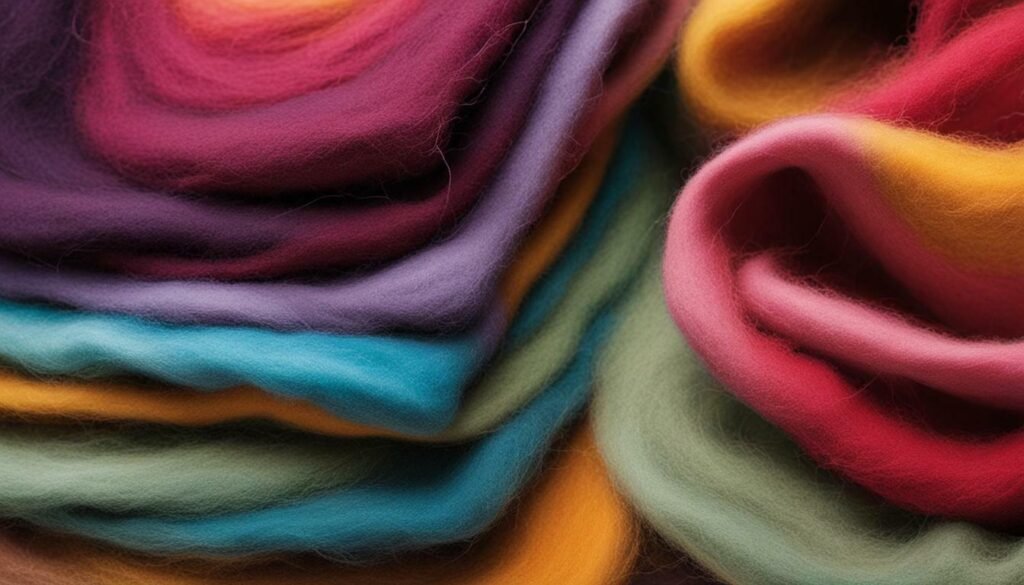
- Dense and durable
- Flexible and easy to shape
- Excellent insulating properties
- No fraying when cut
Tools and Materials for Felt Crafting
Before you start your felt crafting project, make sure you have all the necessary tools and materials at hand. Investing in quality materials will ensure that your creations turn out exactly the way you envisioned them. Here are some essential items you might need:
- Felting Needles: There are different types of felting needles available, such as fine, medium, and coarse needles. Choose the needle size and shape that is appropriate for your project.
- Felting Mats: Use a foam block or brush-like mat to protect your work surface and to help push the fibers into shape.
- Wool Roving: Choose from a variety of wool roving, including merino, corriedale, and alpaca. Choose the color and texture that suits your project.
- Scissors: Use sharp scissors to cut your wool and fabric pieces neatly.
- Fabric Glue: Use fabric glue to attach fabric pieces to your felted designs.
- Embellishments: Add a personal touch to your felted creations with embellishments like beads, sequins, and buttons.
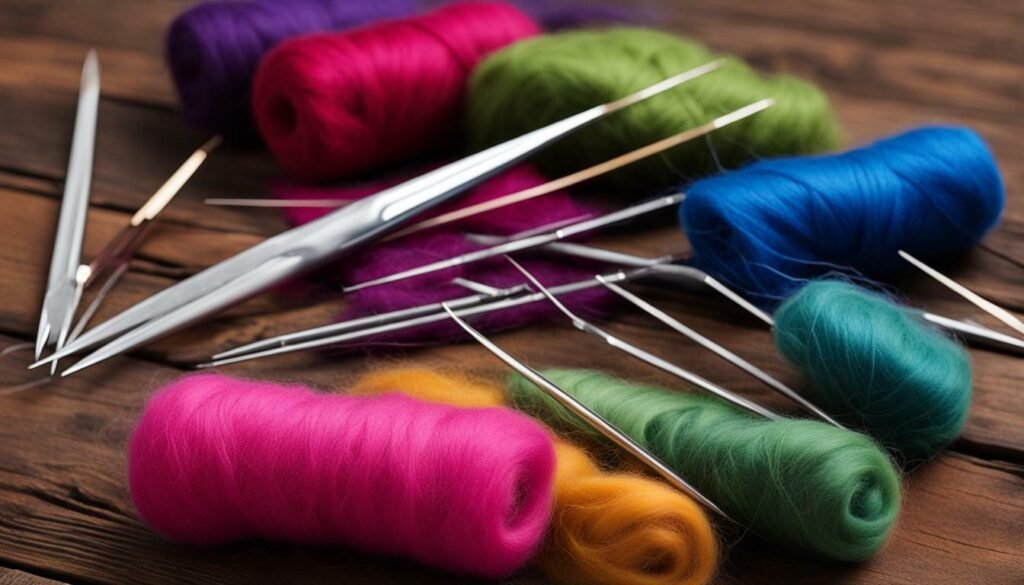
Be creative with your tools and materials. There are plenty of supplies that you can use to enhance your felt crafting projects. Keep experimenting with different types of fibers, colors, and textures, and you will be amazed at what you can create.
Needle Felting: Creating Three-Dimensional Designs
Needle felting is a fascinating technique that allows you to create intricate three-dimensional designs using felt. Here’s how:
- Choose the wool roving colors you’ll need for your design.
- Start with a base shape, usually made of foam or another soft material.
- Take a small piece of wool roving and shape it into a loose ball.
- Hold the wool ball against the base shape and use a felting needle to repeatedly poke the wool down into the shape. This process compresses the wool and binds it together with the wool below it.
- Add more wool as needed, shaping and felting as you go.
- Continue felting until your design has the desired shape and texture.
Some tips for success:
- Start with a simple design and work your way up to more complex ones.
- Use a felting mat to protect your work surface and your fingers from the sharp felting needle.
- Handle the wool gently to avoid pulling the fibers apart.
- Experiment with different types of felting needles to achieve different effects, such as shaping or blending colors.
- Don’t be afraid to make mistakes – needle felting is a forgiving technique, and you can always add more wool or reshape as needed.
Ready to try your hand at needle felting? Here’s some inspiration to get you started:
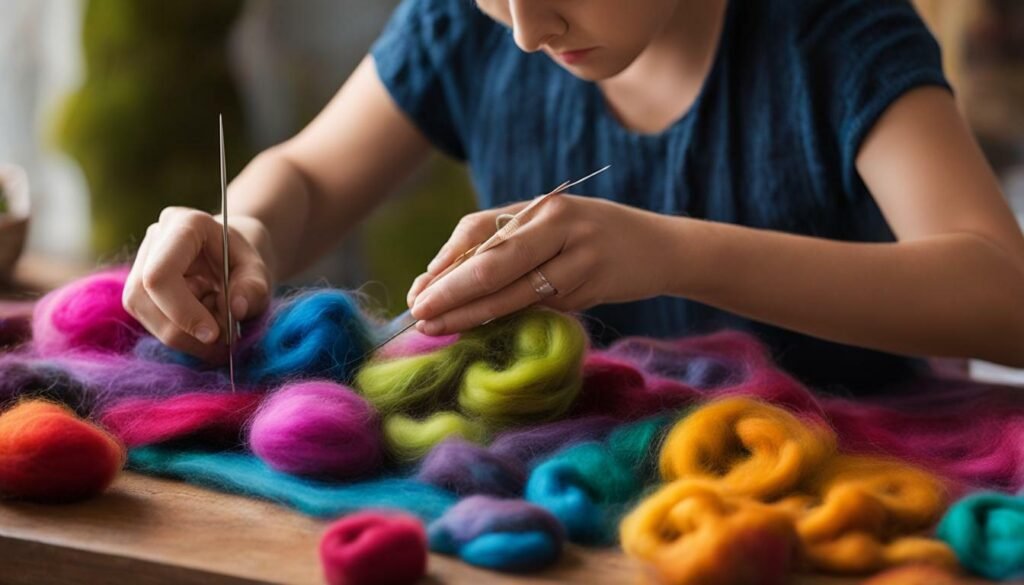
Wet Felting: Unleashing Your Creativity with Water
Get ready to dive into the world of wet felting! This versatile technique involves using water, soap, and agitation to create seamless felted designs. Here are some tips for unleashing your creativity:
- Choose the right wool: Different wool fibers have varying degrees of felting abilities. Merino wool is a popular choice for wet felting because of its fine texture and softness.
- Layer and design: Wet felting allows you to combine colors and shapes to create unique designs. Layer wool fibers on top of each other and add details like silk or yarn to create texture and interest.
- Agitate and felt: The key to wet felting is agitation. Use your hands to press, roll, and rub the wool fibers together. Add hot water and soap to help the fibers fuse together, and keep agitating until your felt has reached the desired thickness and texture.
- Rinse and shape: Once your felt has been felted, rinse it in cold water and press out excess water. To shape your felt, use a form or mold to reshape it while still wet, then let it dry completely.
Unleash your creativity with wet felting and let the water guide your artistry. Don’t be afraid to experiment with different designs and techniques – some of the best felted creations are born from happy accidents!
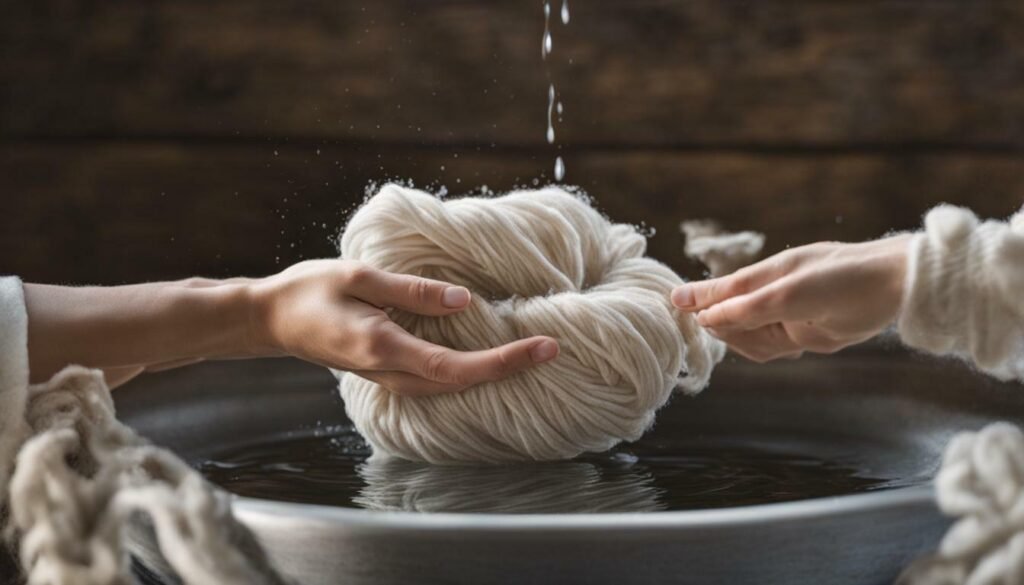
Take your felt crafting to a new level by exploring the beautiful world of nuno felting. This technique combines the softness and texture of felt with the drape and weight of fabric, resulting in stunning mixed media creations.
To create nuno felted pieces, you’ll need lightweight fabrics such as silk or cotton gauze and wool roving. Layer the wool on top of the fabric, wet it with soapy water, and agitate it until the fibers bond together with the fabric. The result is a beautiful, flexible, and textured fabric perfect for creating scarves, garments, and home decor items.
Here are some tips to get you started with nuno felting:
- Choose lightweight fabrics that will drape well, such as silk chiffon or cotton gauze.
- Experiment with layering different colors and types of wool roving to create unique textures and patterns.
- Use a rolling mat or pool noodle to roll and shape your nuno felted pieces.

Embroidery and Appliqué Techniques for Felt
Enhance your felted creations with the art of embroidery and appliqué. These techniques allow you to add unique designs, textures, and embellishments to your felted projects. Here are some tips to get you started:
- Choose the right embroidery thread and needle for your project.
- Experiment with different types of stitches, such as the straight stitch, backstitch, and satin stitch, to add texture and interest to your designs.
- Use appliqué to add fabric pieces or other materials onto your felted base to create dimension and interest.
- Get creative with your designs and try incorporating embroidery or appliqué as a focal point or finishing touch.
Remember, embroidery and appliqué are versatile techniques that can be used in a variety of ways to enhance your felted creations. Have fun experimenting and adding your own personal touch!
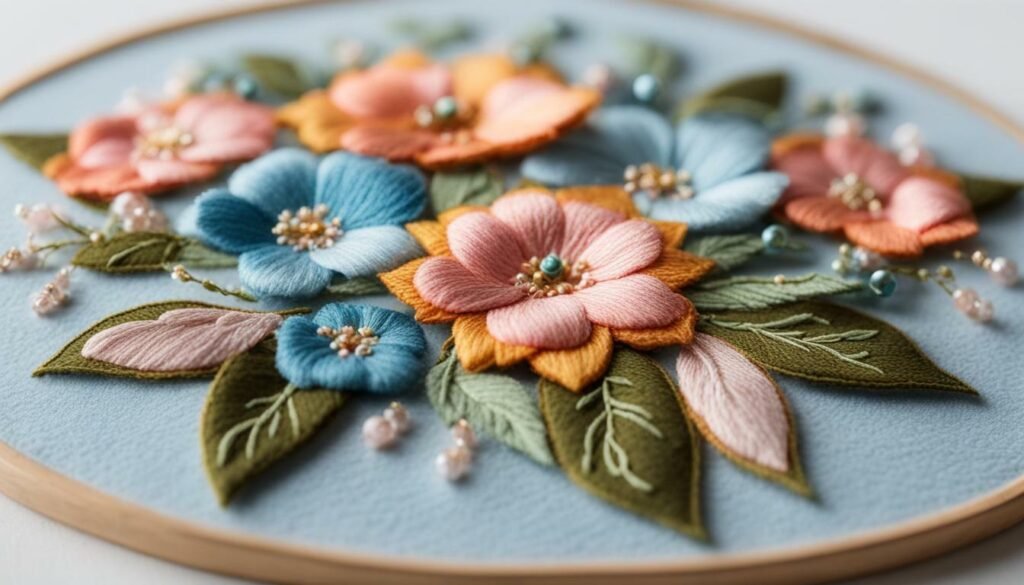
Transform your felted creations into vibrant works of art with felt painting. This technique allows you to add depth, texture, and color to your felted canvas. Here are some painting techniques to try:
- Wet-on-wet technique: apply water to your felted canvas, then add color pigments. The colors will blend together for a soft, dreamy effect.
- Dry-brushing: apply a small amount of paint to a dry brush and lightly brush onto your felted canvas for a subtle, textured look.
- Layering: build up layers of color and texture to create a multidimensional piece.
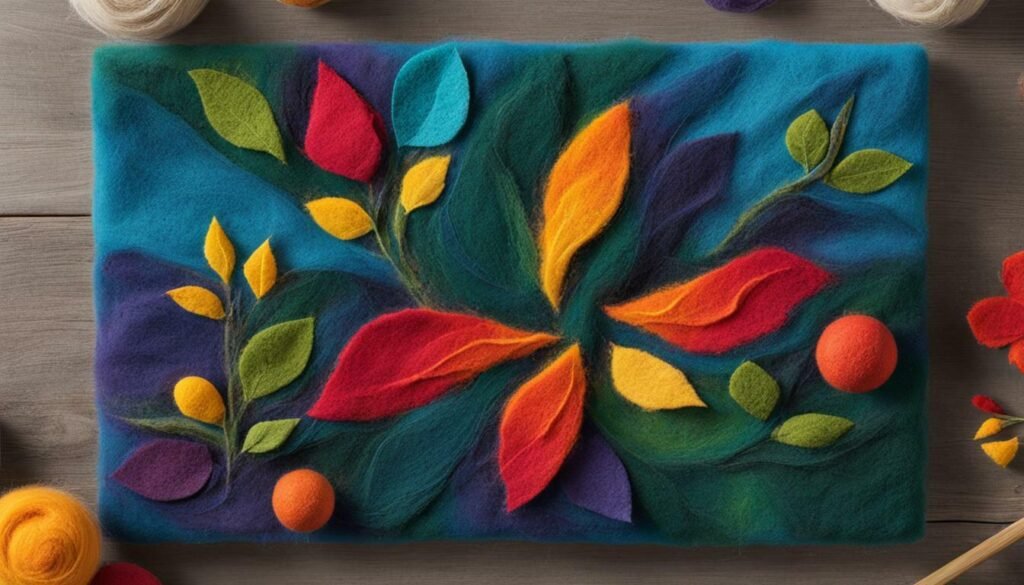
Experiment with different color combinations, painting styles, and techniques to create unique and stunning felt paintings. Don’t be afraid to let your creativity run wild and add your personal style to your felted art.
Felted Jewelry: Making Wearable Art
Add a touch of elegance to your wardrobe with felted jewelry. Not only is it stylish, but it’s also comfortable to wear. From bold statement necklaces to delicate earrings, the possibilities are endless. Here are some tips for creating your own wearable art:
- Choose high-quality wool roving in a variety of colors to create unique designs.
- Use different felting techniques, such as needle felting or wet felting, to achieve different textures and shapes.
- Incorporate other materials, such as beads, wire, or fabric, to add dimension and interest to your jewelry pieces.
- Experiment with different styles, from chunky statement pieces to dainty, delicate designs.
With a little creativity and skill, you can create beautiful jewelry pieces that are sure to turn heads. So why not add a touch of flair to your wardrobe with felted accessories?
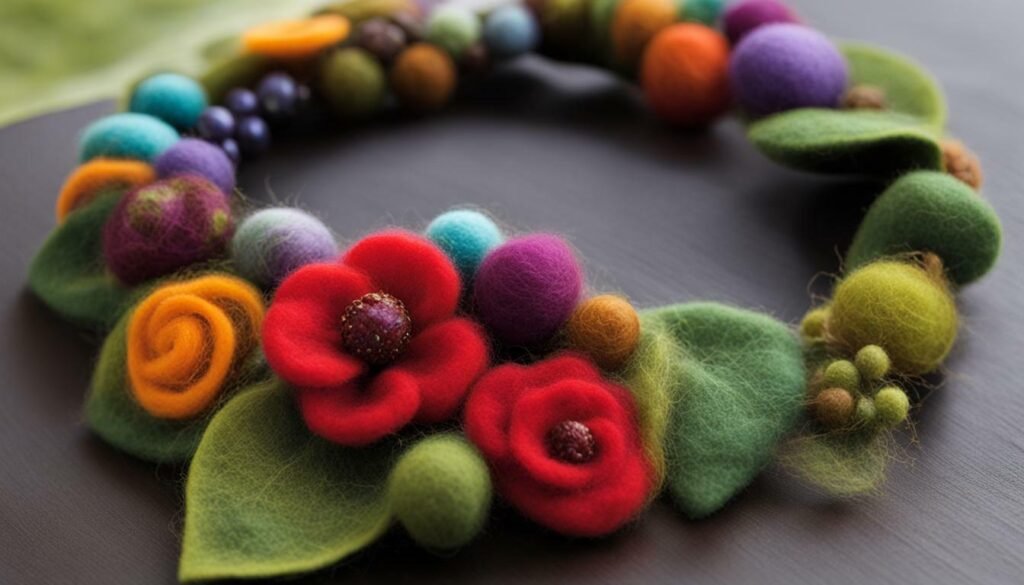
Bring a touch of whimsy to your felt crafting with adorable felted toys and ornaments. Whether you’re creating charming characters, festive decorations, or unique designs, felting techniques can help you craft whimsical wonders that will delight any audience. Here are some tips for creating your own felted toys and ornaments:
- Choose the right colors and materials for your designs.
- Use needle felting or wet felting techniques to create three-dimensional designs.
- Add embroidered details or appliqué for extra flair.
- Experiment with different shapes and sizes to create a variety of toys and ornaments.
With a little creativity and some felting know-how, you can craft whimsical toys and ornaments that will add a touch of magic to any occasion.
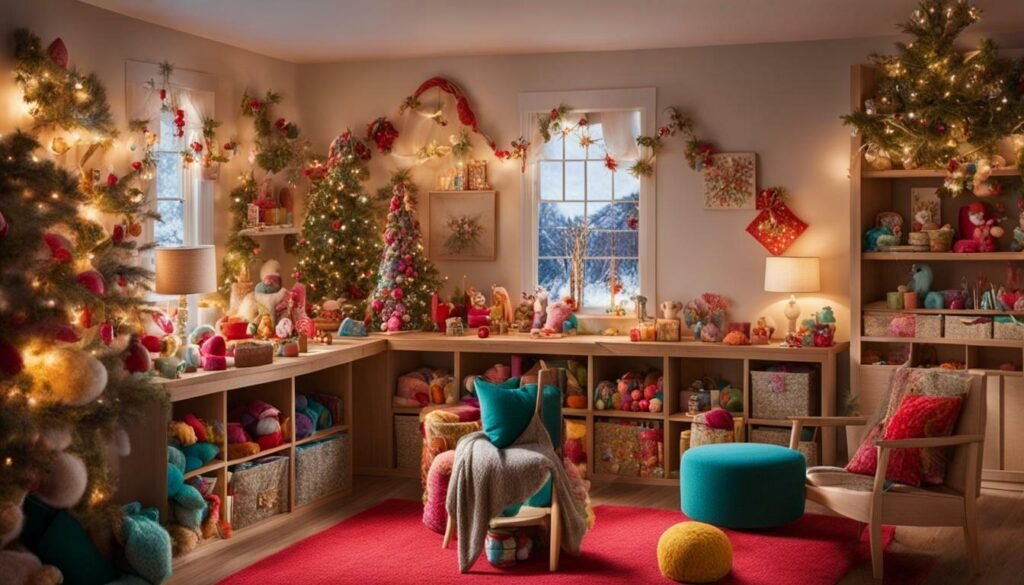
Transform your home into a cozy and inviting space with felted home decor pieces. The tactile nature of felt adds texture and warmth to any room, creating a comfortable and stylish atmosphere. Here are some ideas for incorporating felted home decor into your living space:
- Make a felted pillow cover using different shades of wool roving to create a stunning ombre effect.
- Create a felted wall hanging by felting colorful wool onto a sturdy backing fabric.
- Use felted coasters to protect your tabletops while adding a pop of color and texture.
Remember, the possibilities are endless when it comes to felted home decor. Experiment with different shapes, colors, and textures to create unique pieces that reflect your personal style and taste. Whether it’s a cozy felted blanket or a whimsical felted garland, your felted creations are sure to add charm and character to your home.
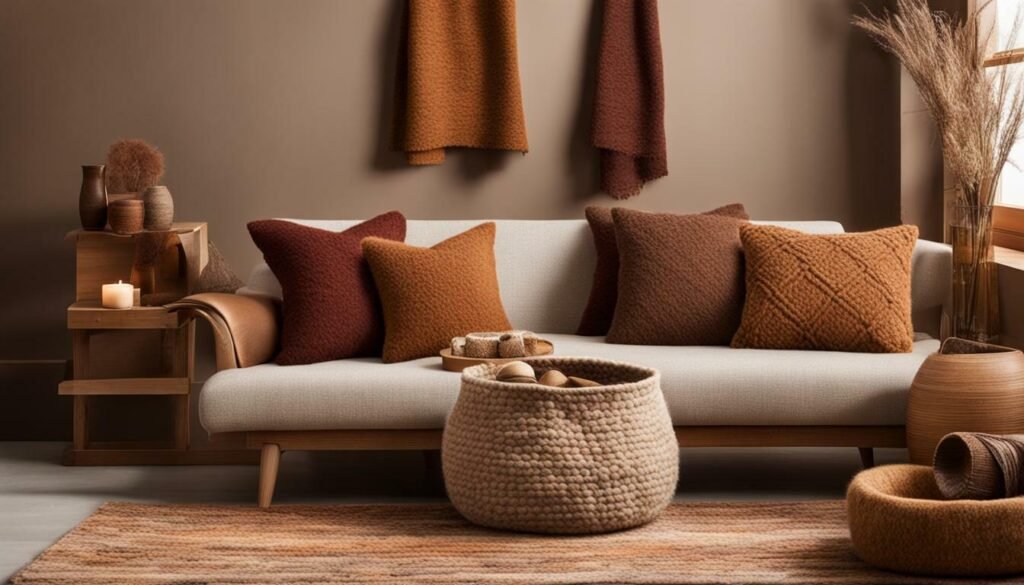
Upcycling with Felt: Sustainable Crafting
If you’re looking to reduce waste and practice sustainable crafting, upcycling with felt is a great way to start. Here are some ideas for incorporating upcycled materials into your felt projects:
- Repurpose old sweaters or clothing into felted coasters, placemats, or other home decor items.
- Use scraps of fabric to create unique nuno felted designs.
- Transform old buttons, beads, and other embellishments into new felted jewelry pieces.
- Turn plastic bags or packaging into sturdy felted bags or baskets.
By upcycling with felt, you’re not only reducing waste but also giving new life to old materials. It’s a creative and eco-friendly way to craft!

Introducing your children to the world of felting can be a fun and educational experience for both you and your kids. Not only will they have a blast creating their own felted wonders, but they’ll also be developing valuable motor skills and creativity along the way. Here are some felting techniques for kids that are perfect for all ages:
- Wet felting: Using soap, water, and wool roving, kids can create colorful and textured felted designs on flat surfaces or even 3-dimensional shapes like balls.
- Needle felting: Kids can use special felting needles to sculpt wool roving into different shapes and designs. This can be a great way to create little felted animals or characters.
- Felted jewelry: Kids can create their own stylish accessories by felting wool roving into unique shapes and adding embellishments like beads or buttons.
Not only are these felting techniques fun for kids to do, but they also offer opportunities for educational projects. Kids can learn about different types of wool, the properties of felt, and how to mix colors and textures to create unique designs.
Keep in mind that felting needles can be sharp, so it’s important to supervise younger children and provide guidance as needed. But with your help and encouragement, your kids will be creating their own felted masterpieces in no time.

As with any craft, felting can come with its own set of challenges. Here are some common felt crafting issues you may encounter:
- Uneven felting
- Holes or tears in your design
- Colors bleeding or fading after felting
- Difficulty in shaping or detailing your design
- Experiencing pain or discomfort in your hands from prolonged use of felting needles
If you face any of these issues, don’t worry – there are solutions to help you overcome them:
- Ensure that you are using consistent pressure when felting to create an even finish
- Use extra wool fibers to patch up holes or tears, or consider incorporating them into your design for a unique touch
- Pre-soak your wool in vinegar or salt to prevent bleeding or fading, or use high-quality dyes that are specifically designed for felting
- Practice and experiment with different needle types and techniques to achieve your desired shape and level of detail
- Take frequent breaks and consider using ergonomic needles or a felting machine to reduce hand strain
By troubleshooting these common issues and seeking out solutions, you’ll be better equipped to create flawless felted wonders. Don’t be afraid to experiment and try new techniques – sometimes the best creations come from unexpected challenges.
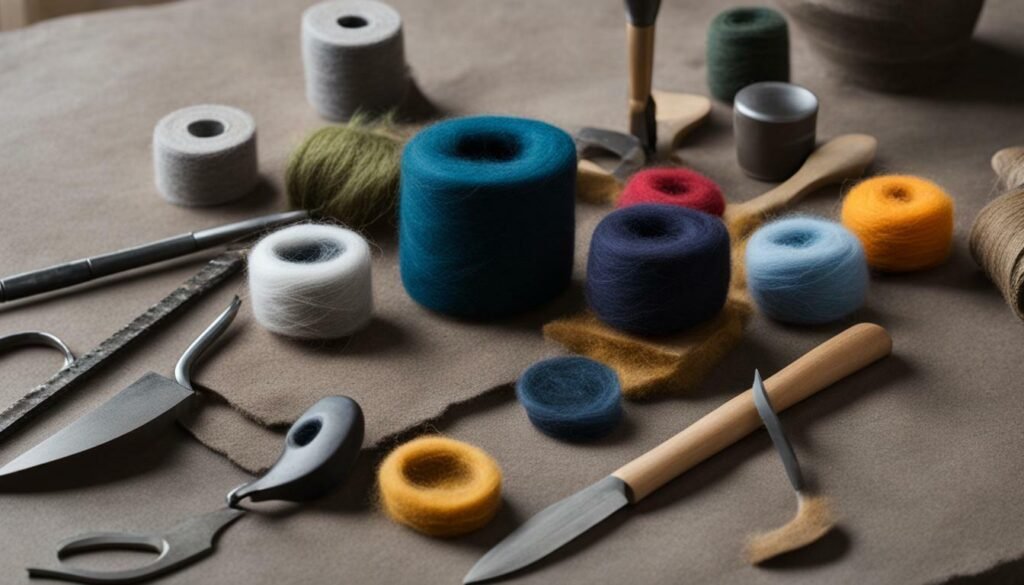
Adding the right finishing touches can elevate your felted creations from ordinary to extraordinary. Here are some tips on how to embellish and finish your projects:
- Use embroidery thread or floss to add intricate details and textures to your felted designs.
- Experiment with different trims, such as lace, ribbons, and pom-poms, to add interesting textures and visual interest to your projects.
- Add buttons, beads, or sequins to your felted creations for a touch of sparkle and dimension.
- Try using fabric paint or markers to create unique patterns and designs on your felted canvas.
When it comes to finishing techniques, here are some options to consider:
- Use invisible or ladder stitching for a seamless finish on your felted creations.
- Apply a layer of clear fabric glue to the edges of your felted designs to prevent fraying.
- Use a blanket stitch to add a decorative edge to your felted projects.
Remember to experiment with different embellishments and finishing techniques to find what works best for your felted creations. And don’t be afraid to add your own personal touch to each project!
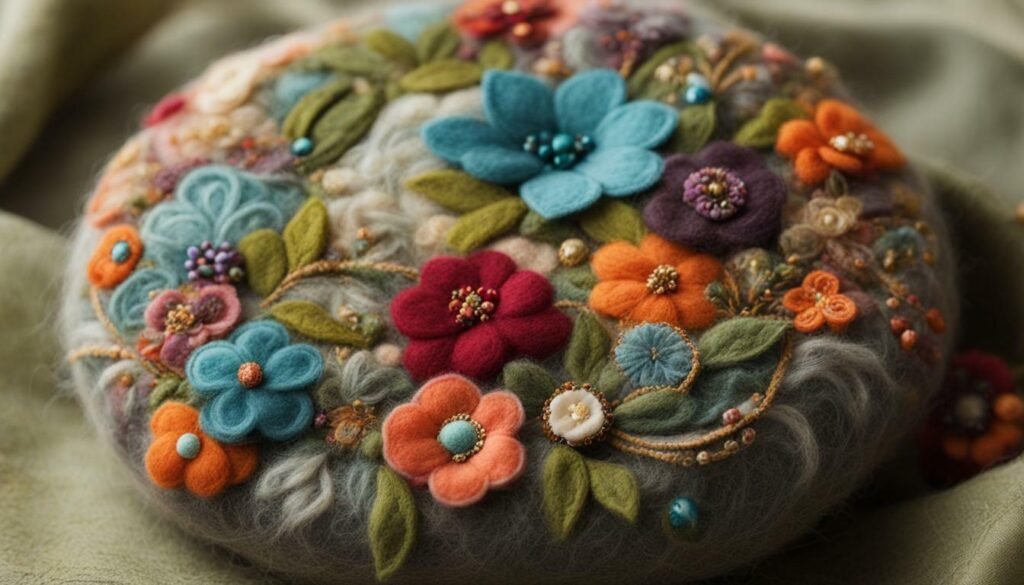
Adding the right embellishments and finishing techniques can give your felted creations a unique and polished look.
Showcasing Your Felted Masterpieces and Finding Inspiration
After putting in the time and effort to craft your felted creations, it’s time to showcase them and get inspired for future projects. Here are some tips to help you display your felted masterpieces and find inspiration:
- Show off your work: Take photographs of your felted creations and share them on social media. You can also participate in crafting communities online or in person to connect with other felt crafters and show off your work.
- Display your creations: Whether it’s a wall hanging, a sculpture, or a wearable accessory, showcase your felted creations in your home or at a local art show. Use unique frames, stands, or display cases to give your pieces a professional touch.
- Get inspired: Explore different sources of inspiration for your next felted project. Look to nature, art, fashion, or culture for ideas. You can also browse crafting books, online tutorials, or attend workshops to learn new techniques and get inspired.
- Connect with others: Attend local crafting events or join crafting groups to meet other felt crafters and share ideas. You can also find inspiration and connect with other crafters on social media or through crafting forums.
With these tips, you can showcase your felted masterpieces and find inspiration for your next project. Keep exploring the world of felt crafting and let your creativity soar.
FAQ
What is felt crafting?
Felt crafting is the art of creating various objects and designs using felt fabric. It involves techniques such as needle felting, wet felting, and nuno felting to shape and mold the felt into desired shapes and forms.
Can anyone do felt crafting?
Yes! Felt crafting is suitable for crafters of all skill levels, from beginners to experienced artisans. Our step-by-step guides and tutorials are designed to cater to different crafting needs and help you improve your skills.
What materials do I need for felt crafting?
The materials you need for felt crafting include felting needles, wool roving, a felting mat, and various felting tools. Additionally, depending on the specific technique you’re using, you may need water, soap, fabric, and embroidery threads.
How do I choose the right felting needles?
The choice of felting needles depends on the project and the desired effect. Fine-gauge needles are suitable for adding intricate details, while coarse-gauge needles are ideal for shaping and firming the felt.
Can I wash felted items?
It is generally not recommended to wash felted items, as they can shrink or lose their shape. However, spot cleaning with a gentle detergent may be possible. Always refer to the care instructions for your specific felted creation.
How can I fix mistakes or errors in my felted projects?
If you make a mistake while felting, such as poking a hole or creating an unintended shape, you can usually fix it by felting or needle felting additional fibers to blend and cover the mistake. For more complex errors, you may need to start over with a new piece of felt.
Where can I find inspiration for my felt crafting projects?
There are many sources of inspiration for felt crafting, including nature, art, and other crafters. You can also join online communities or attend craft fairs and workshops to connect with fellow crafters and learn new techniques.
Can I sell the felted items I create?
Absolutely! Many crafters sell their felted creations through online marketplaces, craft fairs, or their own websites. Just make sure to comply with any local regulations and check if there are any specific labeling or safety requirements for the items you plan to sell.
Are there any safety precautions I should take while felting?
When felting, it’s important to be mindful of the sharp needles and avoid pricking yourself. Make sure to work on a stable surface and keep your fingers away from the needle’s point. If working with children, adult supervision is recommended.
